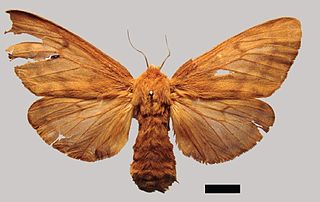Paracles is a genus of moths in the subfamily Arctiinae. The genus was described by Francis Walker in 1855. The species range from Panama to Patagonia, with quite a few in the southern temperate region of South America.

Paracles vulpina is a moth of the subfamily Arctiinae first described by Jacob Hübner in 1825. It is found in Argentina and Brazil.
Paracles amarga is a moth of the subfamily Arctiinae first described by Schaus in 1933. It is found in Argentina.
Paracles brittoni is a moth of the subfamily Arctiinae first described by Rothschild in 1910. It is found in Argentina.

Paracles azollae is a moth of the subfamily Arctiinae first described by Berg in 1877. It is found in Argentina.
Paracles brunnea is a moth of the subfamily Arctiinae first described by Jacob Hübner in 1831. It is found in Brazil, Argentina and Patagonia.

Paracles severa is a moth of the subfamily Arctiinae first described by Carlos Berg in 1875. It is found in Argentina.

Paracles tenuis is a moth of the subfamily Arctiinae first described by Carlos Berg in 1877. It is found in Argentina, Uruguay and Colombia.

Paracles deseticola is a moth of the subfamily Arctiinae first described by Carlos Berg in 1875. It is found in Argentina and Patagonia.

Paracles burmeisteri is a moth of the subfamily Arctiinae first described by Berg in 1877. It is found in Argentina.
Paracles fulvicollis is a moth of the subfamily Arctiinae first described by George Hampson in 1905. It is found in Chile. There are several species in the southern temperate region of South America, from Panama to Patagonia.

Paracles fusca is a moth of the subfamily Arctiinae first described by Francis Walker in 1856. It is found in Brazil and Argentina.
Paracles insipida is a moth of the subfamily Arctiinae first described by Rothschild in 1910. It is found in Argentina.
Paracles magna is a moth of the subfamily Arctiinae first described by Rothschild in 1910. It is found in the northern part of Argentina.
Paracles valstana is a moth of the subfamily Arctiinae first described by Schaus in 1933. It is found in Argentina.
Paracles steinbachi is a moth of the subfamily Arctiinae first described by Rothschild in 1910. It is found in Argentina.
Paracles thursbyi is a moth of the subfamily Arctiinae first described by Rothschild in 1910. It is found in Argentina.
Paracles cnethocampoides is a moth of the subfamily Arctiinae first described by Rothschild in 1910. It is found in Argentina.

Leucanopsis infucata is a moth of the family Erebidae. It was described by Carlos Berg in 1882 and is found in Argentina.

Paracles uruguayensis is a moth of the subfamily Arctiinae first described by Carlos Berg in 1886. It is found in Uruguay.









